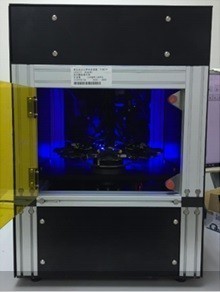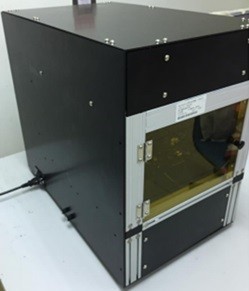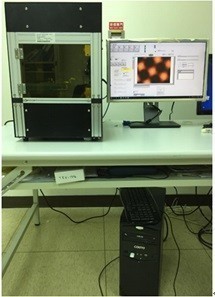| Technical Name | A benchtop platform for rapid detection of pathogens | ||
|---|---|---|---|
| Project Operator | National Cheng Kung University | ||
| Summary | This unique technique achieves rapid, simple and quantitative diagnostics for the AST based on Brownian motion of functionalized particles combining with immunoassays. As bacteria bind to the particles, Brownian motion will decline due to the increase of equivalent particle diameter. This instrument features rapid (<3 h), less wasteful (<3 μL), low-cost and low limit of detection (100 cfu/mL). |
||
| Scientific Breakthrough | For rapid antimicrobial susceptibility testing, there are currently no commercial instruments or technologies available on the market. Generally, the traditional minimum inhibitory concentration (MIC) is used to detect the disc diffusion test. E-test, agar dilution test or broth dilution test is the main method, usually takes one to several days. Automation equipment is BioMérieux VITEK 2 and BD Phoenix systems are the mainstream. The advantage lies in the detection principle of turbidity, redox and so on. The detection result is the closest to the traditional method. However, the acquisition cost is expensive and it takes 8-24 h to know the result. The aim of the project is to develop a fast (<3 h), accurate quantification of bacterial resistance using fluorescent microparticle Brownian motion with only a small (<3 μL) sample and low detection concentration (~100 CFU/mL). The detection technology is called microbead bioparticle detection probe. During the process, we modified the fluorescent particles to specific antibodies (for specific bacteria) or functional groups (for all bacteria) by means of immunization. When there is a specific antigen or target in the specimen solution, the microparticles attached to the bacteria will increase the effective radius, thereby changing the Brownian motion, thereby judging the presence or absence of the pathogen and its precise quantity. Ultimately, it is expected that the established detection methods can achieve the objectives of reducing the time required for the test, consumables, consumables and increasing sensitivity on the technical side. This technology can be applied in the aquaculture industry to detect the number of bacteria in fish farms. It can also be used in the food industry to detect whether the number of bacteria is excessive. In medical treatment, effective antibiotic control and reduction of waste of medical resources are achieved. In the academic field, new application research directions can be opened up. |
||
| Industrial Applicability | 有關市場的分析,整體藥敏測試我們可以分成兩個層面,一個部分是人力密集的手工測試方式,另一個部份就是自動化設備的量測,目前是中大型醫院逐漸用自動化取代,但是無法有效縮短藥敏的時間,在菌種鑑定也是必需的流程,這部份透過mass或是菌種鑑定儀來克服。本次的產品,在微生物檢測中,有一個重要的優勢,就是在藥敏測試時間短很多,但是仍有很多資訊(如微生物種類或是幾種微生物)無法有效的確定。因此會產生幾種策略,第一個是技術移轉給如BD或是羅氏等藥廠,讓它成為藥敏測試的快速藥敏的一環,第二是發展小型藥敏測試快速儀,讓有需要的檢驗室添購,第三,針對非常需要的疾病,如敗血性休克建立機種,成為專用機的概念。而每一種策略所需要的市場與通路都不同,如果走策略一,屬於B TO B的模式,如果走二或三,產品上市會是需要時間及資金的投入,行銷也會有不同的科別。 |
||
other people also saw







